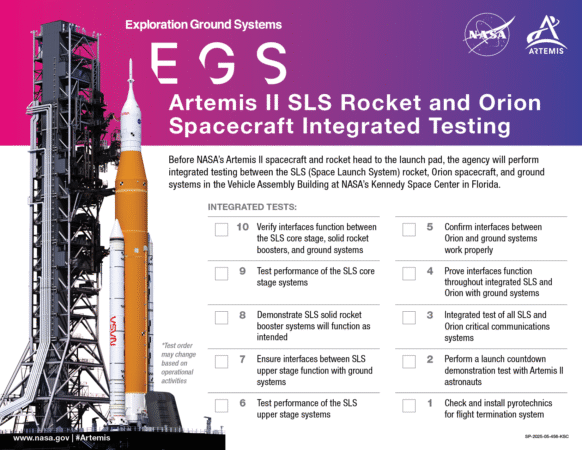Essential Insights
-
Integrated Testing Initiated: NASA teams at Kennedy Space Center are starting integrated tests for Artemis II, aiming to confirm that the SLS rocket and ground systems function and communicate effectively, ahead of the first crewed Artemis mission.
-
Enhanced Pre-Flight Procedures: Unique to Artemis II, additional tests will be conducted focusing on the interfaces and interoperability between the SLS core stage, solid rocket boosters, and ground systems, building on the lessons learned from Artemis I.
-
Launch Day Simulation: A detailed launch day demonstration will include the Artemis II astronauts practicing countdown procedures both in the Vehicle Assembly Building and at the launch pad, ensuring readiness for emergency egress and other critical operations.
- Cryogenic Fuel Handling: Teams will practice cryogenic propellant loading and full countdown sequences at the launch pad, simulating conditions for the actual launch, and ensuring all operations proceed according to the planned timeline.
Integrated Testing on Horizon for Artemis II Launch Preparations
NASA’s Kennedy Space Center in Florida gears up for a crucial milestone in the Artemis II mission. Teams will initiate a series of integrated tests to ensure that all systems work smoothly. With the Space Launch System (SLS) upper stage now integrated with the rocket’s core components, engineers are set to begin these vital assessments.
This testing phase resembles the integrated campaign for Artemis I. However, engineers have expanded the scope for Artemis II, America’s first crewed mission in the Artemis program. This mission will send four astronauts on a 10-day journey around the Moon, marking a significant step toward future lunar and Mars missions.
The integrated tests will verify how well the different rocket systems function and communicate. Engineers will operate from the Launch Control Center, conducting health checks of the SLS core stage, solid rocket boosters, and ground systems. They will ensure that everything from engines to thrust control systems functions as expected.
Following these checks, teams will conduct additional engineering tests on each rocket stage. These efforts will include a detailed interface verification between the SLS core and upper stages, along with the Orion spacecraft. Teams will use radio frequencies to confirm that mission control can communicate effectively with the spacecraft during flight.
A crucial part of the testing involves a launch day demonstration with the Artemis II astronauts. This practice session will simulate launch countdown procedures. The astronauts will suit up, then travel to the Vehicle Assembly Building to enter the Orion spacecraft, allowing them to rehearse for launch day.
Additionally, safety tests are paramount. Teams will ensure the rocket’s flight termination system is operable in case of emergencies. This two-part test will occur inside the Vehicle Assembly Building, focusing on safety protocols before the rocket rollout.
Once at the launch pad, engineers will practice loading cryogenic propellants. Over 700,000 gallons of super-cold propellant will fill the rocket’s tanks. This rehearsal will cover every countdown phase, including weather checks and preparing for any necessary holds. While the Artemis II crew will not be present for this rehearsal, every detail will help refine launch procedures.
As NASA forges ahead with these tests, the mission promises to enhance technology development in space exploration. The Artemis II flight builds on lessons learned from previous missions. Each test paves the way for more ambitious endeavors, including potential human landings on the Moon and missions to Mars, ultimately enhancing the quality of life through advancements in space technology.
Stay Ahead with the Latest Tech Trends
Dive deeper into the world of Cryptocurrency and its impact on global finance.
Access comprehensive resources on technology by visiting Wikipedia.
SciV1

